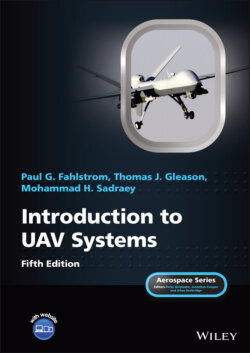Читать книгу Introduction to UAV Systems - Mohammad H. Sadraey - Страница 64
2.4 Expendable UAVs
ОглавлениеExpendable UAVs are not designed to return after accomplishing their mission. In the military world, this often means that they contain an internal warhead and are intended to be crashed into a target destroying it and themselves. This type of expendable is discussed further in Chapter 11 and we make the argument there that it is not really a UAV, but rather a missile of some sort. There is a considerable area of overlap between guided missiles and UAVs, as illustrated by the fact that the first “UAVs” of the aviation era were mostly guided weapons. An alternative definition of an expendable is that it can (and should) be recovered if possible, but can have a very high loss rate.
The electric‐motor‐powered Raven, described in Section 2.3.4, is an example of an expendable, but recoverable, UAV. It is hand launched and uses a hand‐carried ground control station. The Raven is used to conduct reconnaissance missions out to about 5 km and is recoverable, but if it does not return or crashes during landing, the loss is considered acceptable.
However, in the past few years, a new type of lethal UAVs (as loitering munition) has emerged. This precision‐guided loitering munition is a relatively new concept and technology and generates a low (or very low) collateral damage. As example is Switchblade 300 (Figure 2.7), designed and manufactured by AeroVironment. This UAV – which was first fielded by the US Army and Marine Corp in 2011 – utilizes a small munition to break apart prior to impact and has a low acoustic, thermal, and radar signature. Switchblade 300 is interoperable with current Puma, Raven, and Wasp UAV control stations.
Figure 2.7 Switchblade UAV
(Source: Business Wire, Inc.)
This UAV – with a mass of 2.7 kg (weight of 6 lb), a length of 2 ft, and a pusher electric motor – carries a small munition with a range of 10 km; it can be in the air for about 10 minutes. The operating altitude is 500 ft AGL (above ground level) and 15,000 ft MSL (mean sea level), with a cruise speed of 63 mph and a dash of 98 mph. Its tubular fuselage contains the battery, motor, avionics, and a payload (gimbaled nose camera). The UAV is folded inside a tube with wing sections unfolding once it gets airborne. The two wing sections are spring loaded, low‐mounted, and sweep out upon launching.
Switchblade – armed with a 40‐mm grenade‐like warhead – is meant to strike targets beyond the range – or shielded from the line of sight – of the rifles, machine guns, and other weapons of an infantry platoon or squad. Switchblade was fielded on an emergency basis in Afghanistan beginning in 2012.
There are a number of similar UAVs developed by other companies. Examples are Lockheed Martin Terminator, Mistral HERO‐30SF, Textron Systems BattleHawk, SAAB AT4 CS, Booz Allen Hamilton Vampire, Prox Dynamics Black Hornet, and Area‐I Air‐Launched, Tube‐Integrated, Unmanned System, or ALTIUS‐600.
